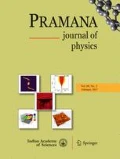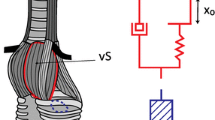Abstract
In this work we report experimental measurements of pressure patterns used in canary song. We find that these patterns are qualitatively similar to the subharmonic solutions of a simple dynamical system. This is built to account for the activities of subpopulations of neurons arranged in a simple architecture compatible with anatomical observations. The consequences of Hebbian plasticity in the coupling between the driving and the driven systems are outlined.
Similar content being viewed by others
References
P Marler and H Slabbekoorn, Nature’s music, the science of birdsong (Elsevier, San Diego, 2004)
F Goller and R A Suthers, Nature (London) 373, 63 (1995)
R A Suthers, How birds sing and why it matters, in Nature’s music, the science of birdsong edited by P Marler and H Slabbekoorn (Elsevier, San Diego, 2004) pp. 272–295
E D Jarvis, Brains and birdsong, in Nature’s music, the science of birdsong edited by P Marler and H Slabbekoorn (Elsevier, San Diego, 2004) pp. 226–271
A J Doupe, M M Solis, R Kimpo and C A Boetinger, Ann. N.Y. Acad. Sci. 1016, 495 (2004)
T Gardner, G Cecchi, M Magnasco, R Laje and G B Mindlin, Phys. Rev. Lett. 87, 208101, 1–4 (2001)
R Laje and G B Mindlin, Phys. Rev. E65 art. 051921, 1 (2002)
G B Mindlin, T J Gardner, F Goller and R Suthers, Phys. Rev. E68, 041908 (2003)
F Goller and R A Suthers, J. Neurophysiol. 75, 867 (1996)
R A Suthers, F Goller and C Pytte, Philos. Trans. R. London B354, 927 (1999)
G B Mindlin and R Laje, The physics of birdsong (Springer, New York, 2005)
F Nottebohm and A P Arnold, Science 194, 211 (1976)
A C Yu and D Margoliash, Science 273, 1871 (1996)
C B Sturdy, J M Wild and R Mooney, J. Neurosci. 23, 1072 (2003)
J Spiro, M Dalva and R Mooney, J. Neurophysiol. 81, 3007 (1999)
R H Hahnloser, A A Kozhevnikov and M S Fee, Nature (London), 419, 65 (2002)
M A Trevisan, G B Mindlin and F Goller, Phys. Rev. Lett. 96, 058103 (2006)
Z Chi and D Margoliash, Neuron 32, 899 (2001)
H D I Abarbanel, L Gibb, G B Mindlin and S Talathi, J. Neurophysiol. 92, 96 (2004)
F C Hoppensteadt and E M Izhikevich, Weakly connected neural networks (Springer-Verlag New York, Inc., Secaucus, NJ, 1997)
O Piro and D Gonzalez, Phys. Rev. A37, 4060 (1988)
M S Brainard and A J Doupe, Nature (London) 417, 351 (2002)
A Pikovsky, M Ronsenblum and J Khurths, Synchronization (Cambridge University Press, 2001)
Author information
Authors and Affiliations
Corresponding author
Rights and permissions
About this article
Cite this article
Arneodo, E.M., Alonso, L.M., Alliende, J.A. et al. The dynamical origin of physiological instructions used in birdsong production. Pramana - J Phys 70, 1077–1085 (2008). https://doi.org/10.1007/s12043-008-0112-2
Published:
Issue Date:
DOI: https://doi.org/10.1007/s12043-008-0112-2




